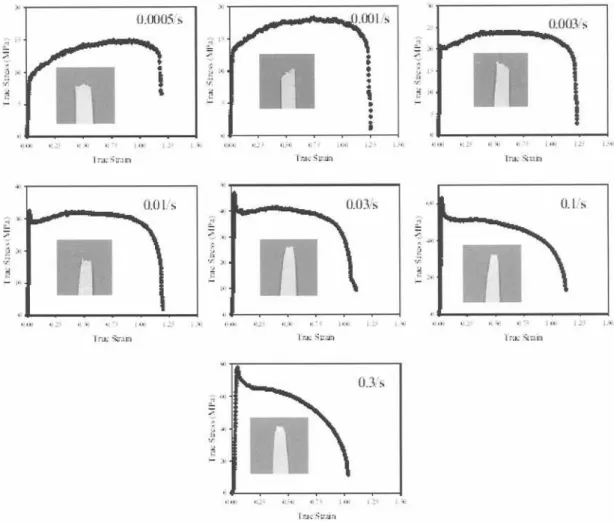Superplastic forming of aluminium alloys: report
Texte intégral
Figure
![Figure 1 Double-action tool technology in the superplastic forming industries outside of GM [2].](https://thumb-eu.123doks.com/thumbv2/123doknet/14188662.477590/8.945.211.696.637.969/figure-double-action-technology-superplastic-forming-industries-outside.webp)
![Figure 3 Principle behind the creep-forming process: a) sheet metal placed in the die; b) vacuum, pressure and heat are applied; c) residual stresses make the shell spring back; d) diagram showing stress relaxation that occurs during creep forming [13].](https://thumb-eu.123doks.com/thumbv2/123doknet/14188662.477590/10.933.244.721.134.778/figure-principle-forming-process-pressure-residual-stresses-relaxation.webp)
![Figure 4 Data for creep deformation in commercial 5000-series alloys are plotted as the logarithm of the Zener- Zener-Hollomon parameter versus the logarithm of modulus-compensated stress [14].](https://thumb-eu.123doks.com/thumbv2/123doknet/14188662.477590/12.933.308.634.397.769/figure-deformation-commercial-logarithm-hollomon-parameter-logarithm-compensated.webp)

Documents relatifs
défense de l'identité professionnelle"; Cette défense est conçue de manière différente, selon que l'on est en présence d'un "corporatisme contractuel", fondé
From the quantitative point of view the state of order is characterized by probabilities of finding various clusters (pairs, triangles, tetrahedra, etc.) of atoms in an alloy.. The
Figure 8: Grain size evolution (Z-N Plane) with respect to the total strain for the three formed parts. 4
Optical (interferometric) determination of the position and orientation of the moving plate as it advances in the cavity. This will include both translatory
The thermomechanical treatment process presented for grain refinement includes furnace cooling from the solution treatment temperature to the overaging temperature, warm rolling
Titanium alloys such as Ti6Al4V and Ti6Al2Sn4Zr2Mo and other Ti alloys are the most employed material in SPF formed parts. It is used mainly for casings and
Pour surmonter cette limitation due au bruit d’intensité, nous proposons l’association d’émetteurs achromatiques insensibles à la polarisation à base d’IL-FP et
That result answers an open problem posed by Gramm, Guo and Nieder- meier in [6] which is the last open problem concerning the APS computational complexity with respect to
![Figure 6 Data for tensile elongation are plotted against the logarithm of the Zener- Hollomon parameter for a number of 5000-series aluminium alloys [14].](https://thumb-eu.123doks.com/thumbv2/123doknet/14188662.477590/14.933.198.632.141.411/figure-tensile-elongation-plotted-logarithm-hollomon-parameter-aluminium.webp)
![Figure 7 Micrographs are shown for (a) the surface of a 5083 tensile coupon at the failure region and (b) the etched cross-section of a failed tensile coupon of the AI-2.8Mg binary alloy [14].](https://thumb-eu.123doks.com/thumbv2/123doknet/14188662.477590/15.918.186.752.384.547/figure-micrographs-surface-tensile-coupon-failure-section-tensile.webp)
![Figure 8 Optical image showing the grain structure near the fracture surface for AA5083 samples tested at 450°C at a strain rate of (a) 0.0005/s and (b) 0.1/s [21].](https://thumb-eu.123doks.com/thumbv2/123doknet/14188662.477590/16.933.174.791.126.353/figure-optical-showing-structure-fracture-surface-samples-tested.webp)
![Figure 10 Data for creep deformation in high-purity AI, low impurity AI-Mg, and low-impurity AI-Mg-Mn alloys are plotted as the logarithm of the Zener-Hollomon parameter versus the logarithm of modulus-compensated stress [14].](https://thumb-eu.123doks.com/thumbv2/123doknet/14188662.477590/19.938.300.629.158.533/deformation-impurity-impurity-logarithm-hollomon-parameter-logarithm-compensated.webp)